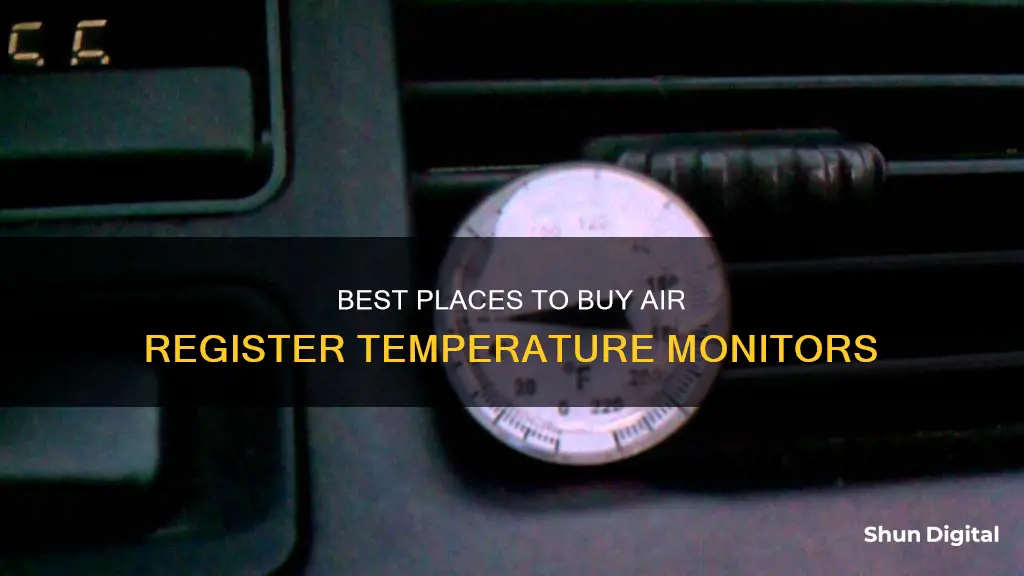
Smart vents are an innovative way to control the temperature of your home. They offer room-by-room climate control, eliminating the common problem of over-heated or over-cooled rooms. There are several smart vent options available on the market, including The Activent, Flair Smart Vent, and SmartCocoon Smart Vent. These smart vents can be purchased from various online retailers, such as Amazon, Best Buy, and directly from the manufacturer's website.
What You'll Learn

Online retailers that sell air register temperature monitors
There are several online retailers that sell air register temperature monitors, which can be used to help manage the climate of individual rooms in your home or office. Here is a list of some of the top online retailers that offer these products:
The Activent
The Activent is a smart product that replaces existing vent/register covers, converting them into active components in a zoned heating and cooling system. It offers a wireless thermostat that can be placed anywhere in the room, signalling the vent to open or close to maintain the desired temperature. You can order The Activent by phone or via its website.
Flair Smart Vents
Flair offers a whole-home smart vent system that integrates with ecobee smart thermostats. The system consists of smart vents and Flair Pucks, which are required for the vents to operate. The Flair Pucks act as dedicated thermostats for each room, managing the environment through sensors that measure temperature, pressure, humidity, and occupancy. Flair products can be purchased through online retailers such as thesmartcave.com.
SmartCocoon
SmartCocoon offers a smart register booster fan that boosts airflow to a single room. It can be installed behind an existing register cover and is equipped with WiFi connectivity, allowing control through the SmartCocoon app. This product can be found on online retailers such as thesmartcave.com.
Airthings
Airthings offers smart indoor radon and air quality monitors that detect radon, PM, VOCs, and other pollutants. Their flagship product, the View Plus, is equipped with seven sensors, including radon, particulate matter, carbon dioxide, airborne chemicals, temperature, air pressure, and humidity. Airthings products can be purchased directly from their website.
Monnit
Monnit provides wireless sensors for remote HVAC monitoring, helping to ensure your heating and cooling systems are functioning properly. Their sensors can monitor a range of variables, including temperature, AC current, vibration, and air velocity. You can learn more about their products and place orders through their website.
SAF Aranet
SAF Aranet offers the Aranet 4, a CO2 monitor that can be used to measure the concentration of carbon dioxide in indoor spaces. The device uses a non-dispersive infrared (NDIR) sensor, considered the most accurate and durable type outside of laboratory-grade equipment. The Aranet 4 can be purchased online through retailers such as Home Depot.
These are just a few examples of online retailers that sell air register temperature monitors. Each company offers unique features and capabilities, so be sure to explore their websites to find the product that best suits your needs.
Removing Pen Ink from LCD Monitors: A Step-by-Step Guide
You may want to see also

Smart vents for room-by-room climate control
Smart vents are an innovative way to achieve room-by-room climate control without the need for expensive zoning systems or decentralised heating solutions. These vents can be installed in place of existing vent/register covers, converting them into active components in a zoned heating and cooling system.
The two most established smart vent systems currently on the market are Flair and SmartCocoon. Flair is the most popular and established option, with the ability to integrate with popular smart thermostats such as Nest, Ecobee, and Honeywell, as well as voice assistants like Alexa and Google Assistant. The system consists of smart vents and Flair Pucks, which act as dedicated thermostats for each room. The smart vents are battery-powered and use a low-power signal to communicate with the Flair Pucks, which connect to WiFi.
SmartCocoon, on the other hand, is a startup company that offers a smart register booster fan as its flagship product. This device can be installed behind an existing register cover and uses WiFi connectivity to be controlled via a smartphone app. It works with both smart and non-smart thermostats and is an economical solution for boosting airflow to a single problem room.
Other smart vent options include Alea Labs, which is currently testing its product, and Ecovent and Keen Home Smart Vents, which are both out of stock with no indication of restock.
Smart vents are a great way to increase the comfort of your home and save a little on your energy bill. They are relatively inexpensive and widely compatible with existing smart home platforms and voice assistants.
Is Your Monitor G-SYNC Compatible?
You may want to see also

Wireless sensors for remote HVAC monitoring
Wireless sensors are an essential component of remote HVAC monitoring systems, providing real-time data and alerts on various metrics such as temperature, air velocity, and power consumption. Here are some key insights on wireless sensors for remote HVAC monitoring:
Wireless Sensor Capabilities
Wireless sensors offer a range of features for remote HVAC monitoring:
- Temperature Monitoring: Sensors can track temperatures in ducts, A/C units, boilers, and various spaces to ensure optimal heating and cooling.
- Air Velocity Monitoring: Sensors measure air velocity to optimise performance, improve energy efficiency, and ensure proper airflow for occupant comfort.
- Power Consumption: Sensors can monitor power draw and predict maintenance needs by tracking circuit breakers and voltage ratings.
- Vibration Detection: Sensors detect abnormal vibrations in equipment like boilers to identify potential issues and schedule maintenance.
- Air Quality Monitoring: Sensors can detect airborne viruses, bacteria, and pollutants, ensuring the circulation of clean air.
- Pressure Monitoring: Sensors measure air pressure differences to maintain optimal pressure and prevent issues when opening doors.
Leading Wireless Sensor Solutions
Several companies offer wireless sensors for remote HVAC monitoring:
- Monnit Wireless Sensors: Offers over 80 types of sensors for remote HVAC monitoring, including temperature, duct temperature, air velocity, differential air pressure, and air quality sensors.
- Sensaphone HVAC Remote Monitoring Sensors: Provides sensors for duct airflow measurement, differential pressure, dew point, carbon monoxide, smoke detection, water leaks, and equipment failure.
- The Activent: A smart product that helps manage the climate of individual rooms by converting existing vent/register covers into active components in a zoned heating and cooling system.
- Smart Vent Systems: Companies like Flair and SmartCocoon offer smart vent systems that provide room-by-room climate control, integrating with smart thermostats and voice assistants.
Benefits of Wireless Sensors for HVAC Monitoring
Wireless sensors offer numerous advantages for remote HVAC monitoring:
- Real-time Alerts: Sensors provide instant notifications about abnormal conditions, allowing for prompt action to prevent equipment failures.
- Efficiency and Cost Savings: By optimising performance and identifying issues early, wireless sensors help improve energy efficiency and reduce maintenance costs.
- Remote Access: Wireless sensors enable remote access to HVAC system data, providing peace of mind and the ability to manage systems from anywhere.
- Data Logging: Sensors collect and archive data, providing a historical record for compliance, performance analysis, and system optimisation.
- Flexibility: Wireless sensors can be installed in various locations, including ducts, walls, floors, and ceilings, offering tailored solutions for different spaces.
Monitors: Worth the Investment for Your Setup?
You may want to see also

Air quality sensors
There are a variety of air quality sensors available on the market that can help monitor and improve the air quality in residential spaces. These sensors can detect a range of pollutants and factors that contribute to poor air quality, including:
- Particulate Matter (PM): This includes PM1, PM2.5, and PM10, which are tiny particles emitted from engines, factories, and other sources of combustion. PM2.5, in particular, is the most concerning as it can penetrate the lungs and cause respiratory issues.
- Carbon Dioxide (CO2): CO2 levels can build up indoors, especially in tightly sealed homes, and high concentrations can impair cognitive function.
- Volatile Organic Compounds (VOCs): These are chemicals released from paints, cleaning supplies, disinfectants, and other household products. Exposure to high levels of VOCs can irritate the eyes, nose, and throat, and may also be linked to cancer.
- Radon: This is a naturally occurring radioactive gas that can seep into basements and other areas of the home. Radon exposure is a serious health risk and can lead to lung cancer.
- Temperature and Humidity: Monitoring temperature and humidity levels is important for maintaining a comfortable and healthy indoor environment. High humidity can lead to the growth of mould, which can cause respiratory issues and other health problems.
When choosing an air quality sensor for residential use, it is important to consider the specific needs and concerns of the space. Some sensors may also offer additional features such as app connectivity, customisation options, and alerts when certain thresholds are met. Here are some popular options for air quality sensors:
- Airthings View Plus: This sensor measures temperature, humidity, radon, PM2.5, PM1, CO2, and VOCs. It offers a long battery life and can be customised to display the measurements that are most important to the user. It also connects to a smartphone app for real-time and historical data.
- Awair Element: The Awair Element measures temperature, humidity, CO2, VOCs, and PM2.5. It provides an overall air quality grade as well as individual measurements, making it easy to understand the air quality at a glance. It also connects to a smartphone app for detailed information.
- Temtop M10 Air Quality Monitor: This sensor measures PM2.5, VOCs, and formaldehyde. It provides an air quality index (AQI) measurement, which gives an average reading over time. However, it does not offer an app or additional measurements such as CO2 levels.
- SAF Aranet 4: This sensor specifically measures CO2 levels and is one of the most accurate on the market. It also measures temperature and relative humidity, and connects to an app that provides alerts and historical data.
- CompAir: This is a low-cost sensor developed in collaboration with UCL that detects key airborne pollutants, including PM, CO2, and VOCs, as well as temperature and humidity. The data is sent to CompAir's cloud storage for analysis and can be accessed by stakeholders such as landlords and tenants.
Connecting Multiple Monitors to a Car Radio
You may want to see also

Duct temperature sensors
Functionality:
Compatibility:
Features:
These sensors often offer a range of temperature sensing elements, such as Pt 100, Ni 1000, NTC 10k, or NTC 20k. They are designed for precision and accuracy, eliminating the need for individual circuit calibration. Additionally, some sensors have probes that are epoxy-sealed to prevent moisture ingress, enhancing their durability.
Installation and Customization:
Benefits:
By using duct temperature sensors, homeowners can achieve precise climate control in their residences. These sensors help identify issues with the HVAC system, ensuring it runs efficiently and effectively. This not only improves comfort but also contributes to energy savings by optimizing the system's performance.
Sources for Purchase:
When looking to purchase duct temperature sensors, there are several reputable sources to consider. Companies like Honeywell, Temco Controls, Belimo, and Monnit offer a range of sensor options. Additionally, smart home solutions like The Activent and smart vent systems from companies like Flair and SmartCocoon provide advanced climate control capabilities that integrate with duct temperature sensors for a more efficient and customizable indoor environment.
Monitoring iPhone Memory Usage: A Step-by-Step Guide
You may want to see also
Frequently asked questions
Temperature monitors for the home are available at Best Buy, Amazon, and directly from manufacturers such as TheActivent and Monnit.
Some specific temperature monitor products you can buy include the Eve Room Indoor Air Quality Monitor, the ThermoPro TP50 Digital Hygrometer, and the GoveeLife Hygrometer Thermometer.
When looking for a temperature monitor, consider factors such as compatibility with your existing smart home platforms and voice assistants, ease of installation, and the ability to monitor multiple rooms.
Temperature monitors typically use wireless sensors to track temperature and humidity levels in your home. Some advanced systems can also integrate with smart home platforms and voice assistants, allowing for remote control and automation.







